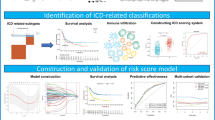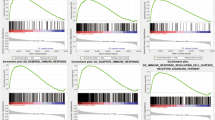Abstract
Purpose
The study aims to investigate the impact of m6A modulators on drug resistance and the immune microenvironment in acute myeloid leukemia (AML). The emergence of drug resistance is a significant factor that contributes to relapse and refractory AML, leading to a poor prognosis.
Methods
The AML transcriptome data were retrieved from the TCGA database. The “oncoPredict” R package was utilized to assess the sensitivity of each sample to cytarabine (Ara-C) and classify them into distinct groups. Differential expression analysis was performed to identify m6A modulators differentially expressed between the two groups. Select Random Forest (RF) to build a predictive model. Model performance was evaluated using calibration curve, clinical decision curve, and clinical impact curve. The impacts of METTL3 on Ara-C sensitivity and immune microenvironment in AML were examined using GO, KEGG, CIBERSORT, and GSEA analyses.
Results
Seventeen out of 26 m6A modulators exhibited differential expression between the Ara-C-sensitive and resistant groups, with a high degree of correlation. We selected the 5 genes with the highest scores in the RF model to build a reliable and accurate prediction model. METTL3 plays a vital role in m6A modification, and further analysis shows its impact on the sensitivity of AML cells to Ara-C through its interaction with 7 types of immune-infiltrating cells and autophagy.
Conclusion
This study utilizes m6A modulators to develop a prediction model for the sensitivity of AML patients to Ara-C, which can assist in treating AML drug resistance by targeting mRNA methylation.






Similar content being viewed by others
Data availability
All the data used in this study are available upon request to the corresponding author.
References
Briot T, Roger E, Thépot S, Lagarce F (2018) Advances in treatment formulations for acute myeloid leukemia. Drug Discov Today 23(12):1936–1949. https://doi.org/10.1016/j.drudis.2018.05.040
Cancro MP, Tomayko MM (2021) Memory B cells and plasma cells: the differentiative continuum of humoral immunity. Immunol Rev 303(1):72–82. https://doi.org/10.1111/imr.13016
Chen H, Xiang Y, Yin Y, Peng J, Peng D, Li D et al (2021) The m6A methyltransferase METTL3 regulates autophagy and sensitivity to cisplatin by targeting ATG5 in seminoma. Transl Androl Urol 10(4):1711–1722. https://doi.org/10.21037/tau-20-1411
Dou L, Xu Q, Wang M, Xiao Y, Cheng L, Li H et al (2019) Clinical efficacy of decitabine in combination with standard-dose cytarabine, aclarubicin hydrochloride, and granulocyte colony-stimulating factor in the treatment of young patients with newly diagnosed acute myeloid leukemia. Onco Targets Ther 12:5013–5023. https://doi.org/10.2147/ott.S200005
Estey EH (2018) Acute myeloid leukemia: 2019 update on risk-stratification and management. Am J Hematol 93(10):1267–1291. https://doi.org/10.1002/ajh.25214
Gu J, Zhan Y, Zhuo L, Zhang Q, Li G, Li Q et al (2021) Biological functions of m(6)A methyltransferases. Cell Biosci 11(1):15. https://doi.org/10.1186/s13578-020-00513-0
Hedrick CC, Malanchi I (2022) Neutrophils in cancer: heterogeneous and multifaceted. Nat Rev Immunol 22(3):173–187. https://doi.org/10.1038/s41577-021-00571-6
Jia G, Fu Y, Zhao X, Dai Q, Zheng G, Yang Y et al (2011) N6-methyladenosine in nuclear RNA is a major substrate of the obesity-associated FTO. Nat Chem Biol 7(12):885–887. https://doi.org/10.1038/nchembio.687
Lee H, Bao S, Qian Y, Geula S, Leslie J, Zhang C et al (2019) Stage-specific requirement for Mettl3-dependent m(6)A mRNA methylation during haematopoietic stem cell differentiation. Nat Cell Biol 21(6):700–709. https://doi.org/10.1038/s41556-019-0318-1
Lee DSW, Rojas OL, Gommerman JL (2021) B cell depletion therapies in autoimmune disease: advances and mechanistic insights. Nat Rev Drug Discov 20(3):179–199. https://doi.org/10.1038/s41573-020-00092-2
Li Y, Xiao J, Bai J, Tian Y, Qu Y, Chen X et al (2019) Molecular characterization and clinical relevance of m(6)A regulators across 33 cancer types. Mol Cancer 18(1):137. https://doi.org/10.1186/s12943-019-1066-3
Li B, Jiang J, Assaraf YG, Xiao H, Chen ZS, Huang C (2020) Surmounting cancer drug resistance: new insights from the perspective of N(6)-methyladenosine RNA modification. Drug Resist Updates 53:100720. https://doi.org/10.1016/j.drup.2020.100720
Lin Z, Niu Y, Wan A, Chen D, Liang H, Chen X et al (2020) RNA m(6) A methylation regulates sorafenib resistance in liver cancer through FOXO3-mediated autophagy. EMBO J 39(12):e103181. https://doi.org/10.15252/embj.2019103181
Luo Y, Sun Y, Li L, Mao Y (2020) METTL3 may regulate testicular germ cell tumors through EMT and immune pathways. Cell Transpl 29:963689720946653. https://doi.org/10.1177/0963689720946653
Mishra SK, Millman SE, Zhang L (2023) Metabolism in acute myeloid leukemia: mechanistic insights and therapeutic targets. Blood 141(10):1119–1135. https://doi.org/10.1182/blood.2022018092
Roloff GW, Griffiths EA (2018) When to obtain genomic data in acute myeloid leukemia (AML) and which mutations matter. Blood Adv 2(21):3070–3080. https://doi.org/10.1182/bloodadvances.2018020206
Sakamoto KM, Grant S, Saleiro D, Crispino JD, Hijiya N, Giles F et al (2015) Targeting novel signaling pathways for resistant acute myeloid leukemia. Mol Genet Metab 114(3):397–402. https://doi.org/10.1016/j.ymgme.2014.11.017
Song H, Song J, Cheng M, Zheng M, Wang T, Tian S et al (2021) METTL3-mediated m(6)A RNA methylation promotes the anti-tumour immunity of natural killer cells. Nat Commun 12(1):5522. https://doi.org/10.1038/s41467-021-25803-0
Tie Y, Tang F, Wei YQ, Wei XW (2022) Immunosuppressive cells in cancer: mechanisms and potential therapeutic targets. J Hematol Oncol 15(1):61. https://doi.org/10.1186/s13045-022-01282-8
Uddin MB, Wang Z, Yang C (2020) Dysregulations of functional RNA modifications in cancer, cancer stemness and cancer therapeutics. Theranostics 10(7):3164–3189. https://doi.org/10.7150/thno.41687
Vu LP, Pickering BF, Cheng Y, Zaccara S, Nguyen D, Minuesa G et al (2017) The N(6)-methyladenosine (m(6)A)-forming enzyme METTL3 controls myeloid differentiation of normal hematopoietic and leukemia cells. Nat Med 23(11):1369–1376. https://doi.org/10.1038/nm.4416
Wang X, Feng J, Xue Y, Guan Z, Zhang D, Liu Z et al (2016) Structural basis of N(6)-adenosine methylation by the METTL3-METTL14 complex. Nature 534(7608):575–578. https://doi.org/10.1038/nature18298
Wang H, Liu YC, Zhu CY, Yan F, Wang MZ, Chen XS et al (2020a) Chidamide increases the sensitivity of refractory or relapsed acute myeloid leukemia cells to anthracyclines via regulation of the HDAC3 -AKT-P21-CDK2 signaling pathway. J Exp Clin Cancer Res 39(1):278. https://doi.org/10.1186/s13046-020-01792-8
Wang X, Wu R, Liu Y, Zhao Y, Bi Z, Yao Y et al (2020b) m(6)A mRNA methylation controls autophagy and adipogenesis by targeting Atg5 and Atg7. Autophagy 16(7):1221–1235. https://doi.org/10.1080/15548627.2019.1659617
Wang P, Feng M, Han G, Yin R, Li Y, Yao S et al (2020c) RNA m(6)A modification plays a key role in maintaining stem cell function in normal and malignant hematopoiesis. Front Cell Dev Biol 9:710964. https://doi.org/10.3389/fcell.2021.710964
Wang L, Hui H, Agrawal K, Kang Y, Li N, Tang R et al (2020d) m(6) A RNA methyltransferases METTL3/14 regulate immune responses to anti-PD-1 therapy. EMBO J 39(20):e104514. https://doi.org/10.15252/embj.2020104514
Wu X, Ye W, Gong Y (2022) The Role of RNA Methyltransferase METTL3 in Normal and Malignant Hematopoiesis. Front Oncol 12:873903. https://doi.org/10.3389/fonc.2022.873903
Xue C, Chu Q, Zheng Q, Jiang S, Bao Z, Su Y et al (2022) Role of main RNA modifications in cancer: N(6)-methyladenosine, 5-methylcytosine, and pseudouridine. Signal Transduct Target Ther 7(1):142. https://doi.org/10.1038/s41392-022-01003-0
Yankova E, Blackaby W, Albertella M, Rak J, De Braekeleer E, Tsagkogeorga G et al (2021) Small-molecule inhibition of METTL3 as a strategy against myeloid leukaemia. Nature 593(7860):597–601. https://doi.org/10.1038/s41586-021-03536-w
Zeng H, Xu Y, Xu S, Jin L, Shen Y, Rajan KC et al (2021) Construction and analysis of a colorectal cancer prognostic model based on N6-methyladenosine-related lncRNAs. Front Cell Dev Biol 9:6988. https://doi.org/10.3389/fcell.2021.698388
Zhang C, Fu J, Zhou Y (2019) A review in research progress concerning m6A methylation and immunoregulation. Front Immunol 10:922. https://doi.org/10.3389/fimmu.2019.00922
Zheng Z, Zhang L, Cui XL, Yu X, Hsu PJ, Lyu R et al (2020) Control of early B cell development by the RNA N(6)-methyladenosine methylation. Cell Rep 31(13):107819. https://doi.org/10.1016/j.celrep.2020.107819
Zhitomirsky B, Assaraf YG (2016) Lysosomes as mediators of drug resistance in cancer. Drug Resist Updates 24:23–33. https://doi.org/10.1016/j.drup.2015.11.004
Zhu H, Gan X, Jiang X, Diao S, Wu H, Hu J (2019) ALKBH5 inhibited autophagy of epithelial ovarian cancer through miR-7 and BCL-2. J Exp Clin Cancer Res 38(1):163. https://doi.org/10.1186/s13046-019-1159-2
Acknowledgements
The authors would like to thank CJ, ZL, and ZLX for their help with the research.
Funding
This work was supported by the In-Hospital Fund of the First Hospital of Lanzhou University (interdisciplinary project) [No. ldyyyn2020-89].
Author information
Authors and Affiliations
Contributions
YJC and LLL designed the experiments, performed data collection and analysis, and wrote the manuscript. LJL, ZSL, and WS performed data collection and analysis. CJ advised on experimental design and data interpretation. ZL provides funding support for experiments. ZL and ZLX advised on experimental design, assisted in writing the manuscript, and supervised the study.
Corresponding authors
Ethics declarations
Conflict of interest
The authors declare that the publication of this paper has no conflicts of interest.
Ethical approval
This study does not involve ethical issues.
Additional information
Publisher's Note
Springer Nature remains neutral with regard to jurisdictional claims in published maps and institutional affiliations.
Supplementary Information
Below is the link to the electronic supplementary material.
Rights and permissions
Springer Nature or its licensor (e.g. a society or other partner) holds exclusive rights to this article under a publishing agreement with the author(s) or other rightsholder(s); author self-archiving of the accepted manuscript version of this article is solely governed by the terms of such publishing agreement and applicable law.
About this article
Cite this article
Yang, J., Li, L., Cheng, J. et al. The m6A modulator-mediated cytarabine sensitivity and immune cell infiltration signature in acute myeloid leukemia. J Cancer Res Clin Oncol 149, 11457–11469 (2023). https://doi.org/10.1007/s00432-023-05029-x
Received:
Accepted:
Published:
Issue Date:
DOI: https://doi.org/10.1007/s00432-023-05029-x




